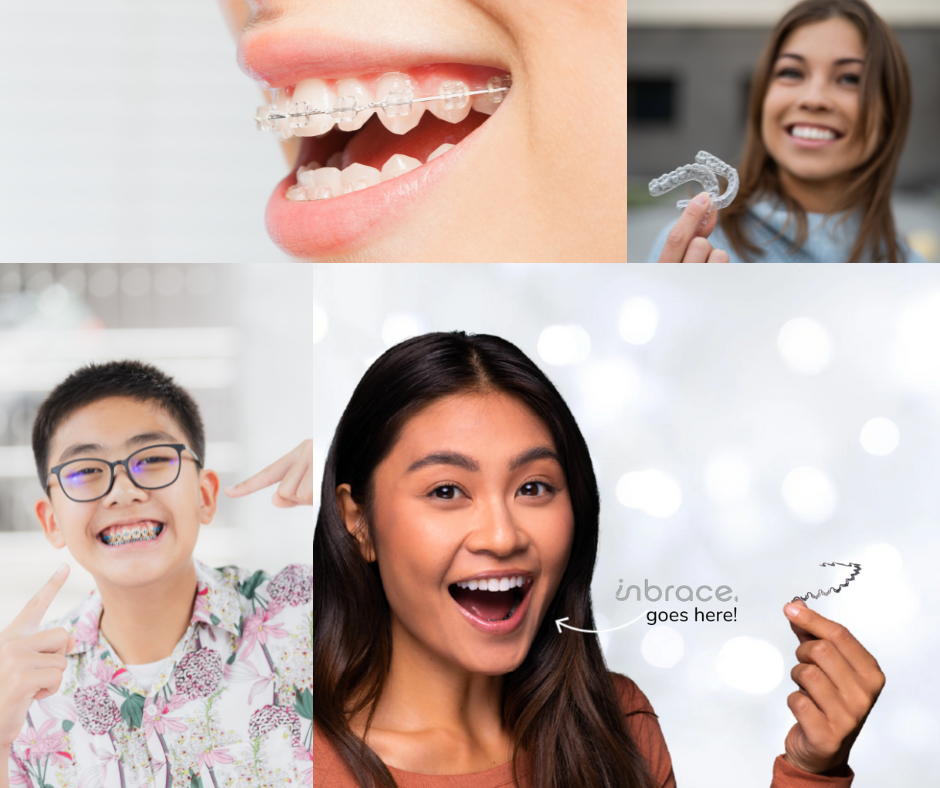both your smile and overall quality of life. The three most common options are traditional braces, InBrace, and clear aligners like Invisalign®. They’re all effective options for straightening your teeth, and they each have their pros and cons. So, how do you know which one is right for you?
Take a look at these six aspects of orthodontic treatments and what you can expect from different orthodontic treatments in those areas.
1. Differences in appearance
Invisalign and other brands of clear aligners are a popular choice because they are virtually invisible and much more discreet than traditional metal braces.
Although traditional braces are visible, there are alternative options that are less noticeable, such as InBrace®, which attaches to the back of the teeth for minimal visibility.
2. Different comfort levels
Whereas any option may cause some discomfort as they move your teeth into place, Invisalign clear aligners are generally more comfortable than traditional braces, which can scratch or cut the inside of your mouth.
Aligners can, however, cause mild discomfort around the gums since the trays cover the entire tooth, all the way up to the gums. Inflammation and slight, occasional bleeding is not uncommon.
InBrace is usually the least comfortable in the first few days after being set, but fades after that and causes little to no discomfort for the rest of their duration.
3. Different effectiveness for different conditions
Braces, aligners, and InBrace are all reliable and effective options for correcting your smile. However, treatments like aligners are most effective when used for mild or moderate cases.
If you have rotated teeth, severe crowding, or significant gaps between teeth, braces or InBrace would be the more effective options.
4. Differences in care and maintenance routines
Both traditional braces and aligners require significant upkeep. When choosing between them, you should consider what sort of maintenance will be easier for you to commit to.
With traditional braces, for example, you have to avoid certain foods that can cause damage to the wires and brackets such as chewy candy or popcorn. With clear aligners, you simply take out the tray while you eat, meaning you don’t have to miss out on any foods or drinks. However, it’s recommended that you brush your teeth after every meal and snack before putting the tray back in.
Invisalign trays must also be worn a minimum of 20-22 hours each day to be fully effective, so you can’t forget to put it back in after you eat.
InBrace requires less maintenance, and you can brush, floss, eat, and drink normally. However, you should still consider avoiding certain foods that can cause potential damage to the wires and brackets such as hard, sticky, and chewy foods.
5. Different lengths of duration
On average, traditional braces need to be worn from a year to two years. Depending on the level of correction required, clear aligner treatment may last anywhere from six months to two years. InBrace duration lasts an estimated six to 18 months.
6. Different required appointment frequency
Traditional braces need to be placed, adjusted, and removed by an orthodontist, which translates to much more time spent at the orthodontist. Clear aligners, on the other hand, require fewer appointments.
Because of InBrace’s Smartwire technology, there are no adjustments or tray changes needed, which significantly cuts down on the amount of appointments you need to make with the orthodontist.
Learn more about your orthodontic treatment options.
South Valley Children’s Dentistry & Orthodontics offers Invisalign, traditional braces, InBrace, and other corrective tools and aligners. Call us today or book online to schedule a consultation and decide which option is right for you.

